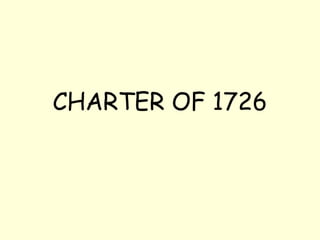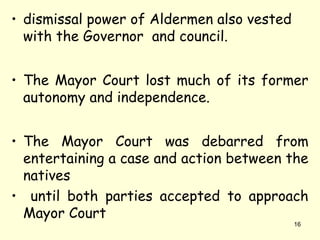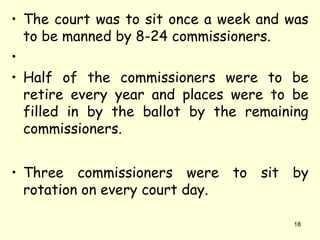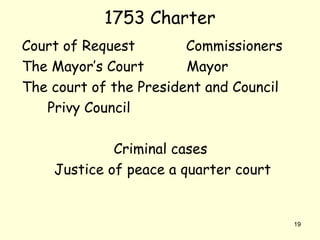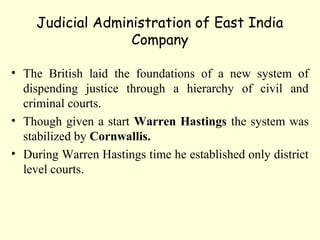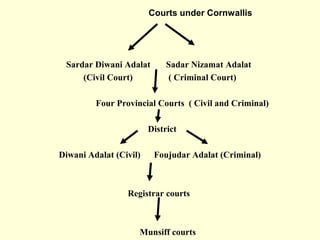Charter of 1726 uniform judicial system & 1753
- 2. • Political and commercial activities of the company were increasing day by day. • Absence of competent court in India. • Many occasions arose when decisions of the courts in India were questioned or contested in the British courts. • Need to create uniform rules and system in corporations of all presidency towns. GENESIS OF THE CHARTER
- 3. • Charter issued to the company by king George I on the 24th sept.1726. • Introduced uniformity of approach in all three presidencies.
- 4. Legislative powers • Established a local legislature in each presidency town. • The Governor-in-Council of each presidency town was entrusted with powers to make by-laws, rules and regulations for better administration in the corporations and settlements with the prior approval of the Board of Directors. • Charter of 1726 for the first time created a subordinate legislative authority in each of the three presidency town of India.
- 5. • Each presidency town was to have a Corporation consisting a Mayor and nine Aldermen. • The Mayor was to hold for a year and was to be continued as Aldermen thereafter. • Every year the Mayor was to be elected from amongst the Aldermen by the Aldermen and out going Mayor. • A vacancy amongst Aldermen was to be filled by the Mayor and the Aldermen from the principal inhabitants of the town. • The Governor-in-Council was empowered to dismiss or remove any Aldermen on reasonable cause
- 6. Changes in Judicial system • The Charter Established Civil and Criminal Courts in the Presidency Towns. • The charter constituted a Mayor’s Court for each of the presidency. • These courts designated as the Royal courts and source of authority was crown, who was regarded as the fountain of justice. • The charter also initiated the system of appeals from the courts in India to King-in-Council or Privy council in England. • Bridge between English and Indian legal system.
- 7. Civil Criminal Mayor court Governor and council 9 Aldermen 5 council members ( 7+2) Sheriff two Aldermen could be subjects of any prince of state in amity with great Britain seven Aldermen had to be the natural born subjects of the Crown. 7
- 8. • In each presidency town the Mayor and two Aldermen were to constitute the mayor’s Court. • The quorum of the court was to be there • Court was to have authority to hear and try all Civil suits arising with in the town and subordinate factories.
- 9. • Criminal jurisdiction in each presidency town was vested in the Governor and five senior members in the Council. • Each of them individually acted as a justice of peace their respective division. • A justice of peace could arrest persons accused of committing crimes, punish those who guilty of minor crimes. CRIMINAL JURISDICTION
- 10. • They hold quarter sessions four times a year to try and punish criminals except high reasons. • All technical forms and procedure of the England criminal justice were introduced in the Presidency towns.
- 11. CHARTER OF 1726 VS. CHARTER OF 1687
- 12. 1726 • Applied to all presidency towns • Jurisdiction in civil cases only • Appeals lay to Governor and council, and then to king- in- Council • Royal court • Court of English law 1687 • Applied to Madras only • Wider jurisdiction (civil and criminal) • Appeals lay to admiralty courts • Company court • Court of equity 12
- 13. Civil Criminal Governor and Council Governor and Council Civil court (Corporation) 5 justice of Peace Mayor Justice of peace court 9 Aldermen 13
- 14. Charter 1753 14
- 15. • To put an end to the administrative problems and disputes in presidency towns in between Governor and Mayor court. Changes • Aldermen were to be appointed by the Governor and Council. • The Mayor, the Governor and Council were to select one out of a panel of two names of Aldermen submitted by the corporation every year. 15
- 16. • dismissal power of Aldermen also vested with the Governor and council. • The Mayor Court lost much of its former autonomy and independence. • The Mayor Court was debarred from entertaining a case and action between the natives • until both parties accepted to approach Mayor Court 16
- 17. • Mayor’s Court was specially empowered to hear suits against the Company. Court of Requests to decided cases cheaply, summarily and quickly, cases up to 15 rupees • To help poor litigants with small claims who could not pay the expenses at Mayor’s Court. 17
- 18. • The court was to sit once a week and was to be manned by 8-24 commissioners. • • Half of the commissioners were to be retire every year and places were to be filled in by the ballot by the remaining commissioners. • Three commissioners were to sit by rotation on every court day. 18
- 19. Court of Request Commissioners The Mayor’s Court Mayor The court of the President and Council Privy Council Criminal cases Justice of peace a quarter court 19 1753 Charter
- 20. Madras judicial system in three stages 1. The High Court of Madras. 1678 2. The Admiralty Court 1683 3. The Mayor Court 1687/88 4. The Choultry Court local court 20
- 21. Bombay 1st Phase Division I Division II Customs officer Customs officer five judges/ five judges/ Justice of peace Justice of peace 21
- 22. II Phase Bombay 1672 Central Court Deputy governor and council Court of Judicature ( weekly ) Civil Criminal Wilcox Wilcox Jury 4 justice of peace Bombay divided in 4 division Each division Court of Conscience Justice of peace court Wilcox Criminal jurisdiction only civil jurisdiction 22
- 23. 1718-1726 3rd Phase Central court Civil and criminal Chief justice 9 judges 5 British 4 natives Hindus, Mohammedans, Portuguese and Christians or Parsis 23
- 24. India Between 1717 to 1765 24
- 26. • In 1717, Farrukhsiyar granted a firman to the East India Company granting them duty-free trading rights for Bengal and strengthening their ports on the east coast. • The state Hyderabad was founded by Nizam- ul-Mulk Asaf Jah in 1724. • Saadat Khan declared himself as a independent ruler in Awadh in 1722. • Mysore was under Haidar Ali. 26
- 27. • Murshid Quli Khan and Alivarthi Khan made Bengal virtually independent in 1717. • After death of Murshid Quli Khan in 1739 Alivarthi Khan became the sole authority of Bengal. • Alivarthi Khan tried to control the British activities in Bengal 27
- 28. • In 1756 Siraj-ud-Daulah grandson of Alivarthi Khan came to throne. • British were imposing heavy taxes on Indian goods entering in Calcutta port. • He ordered both French and British to demolish their forts at Calcutta. • Siraj-ud-Daulah seized the English factory and occupied Ford William on 20th June, 1756. • With the help of Madras naval and army British reoccupied Calcutta in 1757. 28
- 29. • The English Proclaimed Mir Jafar the Nawab of Bengal. • The company was granted undisputed right to free trade in Bengal, Bihar and Orissa. • It also received the zamindari of the 24 Paragana district. • It paved the way for the British power in Bengal. • • The rich revenues of Bengal enabled them to organize to organize a strong army. 29
- 30. 30
- 32. • The Battle of Buxar was fought in October 1764 between the forces under the command of the British East India Company, and the combined armies of • the Nawab of Bengal, • Nawab of Awadh (Shuja-ud-Daula) • the Mughal Emperor (Shah Alam II) • The battle fought at Buxar and the battle won by the forces of the British East India Company. • After the Battle of Buxar, Shah Alam II, the ruling emperor, granted Diwani or tax collection rights over Bengal, Bihar, and Orissa (only Midnapore district) and Clive became the first British Governor of Bengal.
- 33. • Company granted deputy Subahdar, who was to be nominated by the company. • Nizamart or the police and Judicial powers also under British, as deputy Subahdar of Bengal • This arrangement is known in history as the dual or double Government. • The emperor resided in the fort of Allahabad for six years as virtual prisoner of the English company.
- 34. • By 1765 the English East India Company become the real master of Bengal. Its army was in sole control of its defense and the supreme political. • The Nawab of Bengal totally depended upon British for both internal and external security. • As the Diwan the company directly collected its revenue, while though the right to nominate Deputy Subahdar it controlled the Nizmart or the police and Judicial powers. This arrangement is known in history as the dual or double Government
- 35. • Company had power without responsibility. • The Nawab and his officials had the responsibility of administration but not the power to discharge it. • 1766, 1767 and 1768 alone nearly 5.7 million were drained form Bengal. By this time British Govt. observed the wealth of the company and ordered to pay 40,0000 £ for every years. • By 1770 the Bengal suffered form a famine which its effects proved one of the most terrible famine known as human history. • Nearly one lakh people were died and nearly one third of Bengal’s population fell victim to its ravages.
- 36. • Though the famine was due to failure of the rains, its effects were heightened by the Company’s Policies. Expansion of British Power • The Anglo-Mysore Wars were a series of wars fought in India over the last three decades of the 18th century between the Kingdom of Mysore and the British East India Company, represented chiefly by the Madras Presidency . • The fourth war resulted in the conquer of the house of Hyder Ali and Tipu Sultan (who was killed in the final war, in 1799), and the dismantlement of Mysore to the benefit of its pro-British allies.
- 37. MILITARY EXPANSION • The Anglo-Maratha Wars: three wars fought in India between the Maratha Empire and the British East India Company and in the Second Anglo-Maratha War, Marathas defeated by East India Company and agreed the Subsidiary system. • First Anglo-Maratha War 1777, • Second Anglo-Maratha War 1803 • Third Anglo-Maratha War, also known as the Pindari War (1817-1818) finally Peshwa system abolished and Maratha land merged into Company rule.
- 38. WELLESLEY’S SUBSIDIARY SYSTEM: Under his Subsidiary system the ruler of the allying India state was compelled to accept the permanent stationing of British force within his territory and to pay a contributory for its maintance. Nawab of Awad forced to sign in subsidiary system, Krarnataka and Mysore merged in the system by 1801. By1803, English forces defeated Maratha peshwas and signed on subsidiary system The system led to the dismissal of the armies of the protected states. Lakhs of soldiers and official were lost their jobs and livelihood at the same time they became the rivals of the Company.
- 39. DALHOUSIE’S DOCTRINE OF LAPSE 1848-1856 • Under the doctrine, which the ruler of any of the protected state died without a of a natural successor his state was not to pass to an adopted heir as sanctioned by the age old tradition of the country. • Many states including Satara in 1848, Nagapur and Jhansi in 1854 were annexed by applying this doctrine. Dalhousie refused to recognize the title of many ex- rulers or their pensions. • Automatically these policies led towards revolt of 1857.
- 40. • Robert Clive • Lord Warren Hastings • Lord Cornwallis • Lord Wellesley • William Benting • Lord Dollhouse
- 41. Structure of the Government 1757-1857 • By 1784 administration of East India Company had been brought under the control of the British Government and its economic policies were being determined by the needs of British Economy. • There were two reasons behind the British administration. The chief aim of British Indian administration was the maintance of Law and order and the continuation of British rule. Without Law and order British could not hope to sell to their goods in every corner of India.
- 42. • being Foreigners they could not hope to win the affections of the India people. Therefore, relied on superior force rather than on public support for the maintance of their control over India. • The British administration in India was based on three pillars 1. Civil services 2. Army 3. Police
- 43. Civil Services: • The Civil Services were brought into existence by Lord Cornwallis. • The company had form the beginning carried on its trade in the East through servants who were paid low wags automatically it led towards corruption in the servants • Later when the company became a territorial power, the same servants assumed administrative functions and they became extremely corrupt. • Cornwallis, who came to India as Governor General in 1786 was determined to purify the administration and introduced many measures.
- 44. • To avoid corruption in the administration he raised the salaries of the company servants. In fact company’s civil service became the highest paid services in the world in those days. • By 1800 Lord Wellesley established the college of Fort William at Calcutta for the education of young recruits to the civil servants. • Up to 1853 all the appointments to the civil servants were made by the Directors of East India Company. • In 1853 selection of civil servants made through a competitive Examination. A special feature of the Indian Civil Service since the days of Cornwallis was rigid and complete exclusions Indians form it.
- 45. • Army: The second important pillar of the British reign in India was the army. • The bulk of the Company’s army consisted of India soldiers recruited chiefly from area at present in UP and Bihar. • For instance in 1857 the total strength of the army in India was 3,11,400 among them 2,65,900 were Indians. • At the same time there were only three Indian in the army received a salary of Rs. 300 per month and the highest Indian officer was subedar.
- 46. • Police: The third pillar of British rule was the police whose creator was one again Cornwallis. • He established a separate Police force for maintance of Law and Order in Bengal. Like old police system of India a modernized old Indian system Thanas were established headed by a Daroga who was an Indian. • The post of the district superintendent of Police was created to head of the police organization in a district.
- 47. • In the villages the duties of the police continued to be performed by villages’ watchmen. Who were maintained by the villagers. • Establishment of police force resulted a gradual reduction in crimes particularly in dacoit. • The police also prevented the organization of large scale conspiring against foreign control, and when the nature movement arose, the police used to suppress.
- 48. Judicial Administration of East India Company • The British laid the foundations of a new system of dispending justice through a hierarchy of civil and criminal courts. • Though given a start Warren Hastings the system was stabilized by Cornwallis. • During Warren Hastings time he established only district level courts.
- 49. • In each district established a Diwani Adalat of Civil Court and Nizamat Adalat of Criminal courts presided over by the district Judge, who belonged to the civil service and final appellate authority was Sadar Diwani Adalat (Provincial Level ). • Civil courts applied the customary law that had prevailed in any area or among a section of the people since time immemorial. • He introduced a new code in 1793 known as the Cornwallis Code (Judicial reforms) which was based on the principles of separation of powers. • The judicial system set up by Cornwallis was based on principles of equality and western concept of Law.
- 50. Courts under Warren Hastings Sardar Diwani Adalat Sadar Nizamat Adalat (Civil Court) ( Criminal Court) District Diwani Adalat (Civil) Foujudar Adalat (Criminal)
- 51. Courts under Cornwallis Sardar Diwani Adalat Sadar Nizamat Adalat (Civil Court) ( Criminal Court) Four Provincial Courts ( Civil and Criminal) District Diwani Adalat (Civil) Foujudar Adalat (Criminal) Registrar courts Munsiff courts
- 52. To deal with criminal cases • Cornwallis divided the presidency of Bengal into four divisions in each of which a court of circuit presided over by the civil servants was established. • Appeal from the courts of circuits lay with the Sadar Nizamat Adalat. • The criminal courts applied Muslim criminal Law in a modified and less harsh.
- 53. • In 1831 Williams Bentinck abolished the provincial courts of appeal and circuit. He also raised the status and powers of the India in the Judicial service and appointed then as Deputy Magistrates, subordinate Judges. • 1833 Character Act enforced all law making powers on Governor General and his council. • This led that Indian were now to live increasingly under man made laws. • British also established a new system of Law through the process of enactment and codification of law of old law.
- 54. In 1833 government appointed law commission headed by Lord Macaulay to codify Indian laws. Its labour extensively results in the Indian penal Code and Civil Procedure and other codes of Law.
- 55. Legal and Constitutional history of India 55
- 56. • Colonialism, its nature and Introduction on British advent • Judicial pattern between 1726-1773 • Madras, Bombay and Calcutta Judicial system • 1773 Regulating Act • Establishment of supreme court of Calcutta and some cases of Nand Kumar, Patna case, Cossijurah, and Kamaludin • Adalat system and reforms- • Judicial plans of Warren Hastings 1772, 1774,1780 and 1781 56
- 57. • Indian Settlement Act 1781, Pitt’s Act of 1784 • Judicial reforms of Cornwallis 1787, 1790 and 1793. • Development of personal laws and their administration by the British- Defects of Islamic criminal law and development of criminal law. • Charter Act of 1813, 1833, 1853 and Queen’s Proclamation of 1858. • Codification of Laws 1833 and 1853. • Judicial reforms of Lord William Bentinck.57
- 58. • Establishment of High Courts under the Indian High Courts Act, 1861. • Privy Council Federal court -an appraisal • Development of the Legal profession. • Indian Council Act, 1861 • Indian Council Act, 1892 • Indian Council Act, 1909 • Indian Council Act, 1919 • Indian Council Act, 1935 • Government of India Act 1947. 58
